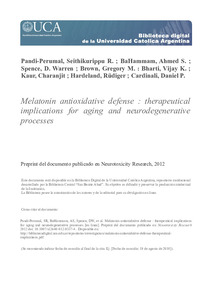Por favor, use este identificador para citar o enlazar este ítem:
https://repositorio.uca.edu.ar/handle/123456789/1620| Título: | Melatonin antioxidative defense : therapeutical implications for aging and neurodegenerative processes | Autor: | Pandi Perumal, Seithikurippu R. BaHammam, Ahmed S. Spence, David Warren Brown, Gregory M. Bharti, Vijay K. Kaur, Charanjit Hardeland, Rüdiger Cardinali, Daniel Pedro |
Palabras clave: | MELATONINA; RADICALES LIBRES; STRESS; ENVEJECIMIENTO; ENFERMEDAD DE PARKINSON; ENFERMEDAD DE ALZHEIMER; ENFERMEDAD DE HUNTINGTON | Fecha de publicación: | 2012 | Editorial: | Springer | Cita: | Pandi-Perumal, S. R., et al. Melatonin antioxidative defense : therapeutical implications for aging and neurodegenerative processes [en línea]. Preprint del documento publicado en Neurotoxicity Research. 2012, 23. doi: 10.1007/s12640-012-9337-4. Disponible en: https://repositorio.uca.edu.ar/handle/123456789/1620 | Resumen: | Abstract: The pineal product melatonin has remarkable antioxidant properties. It is secreted during darkness and plays a key role in various physiological responses including regulation of circadian rhythms, sleep homeostasis, retinal neuromodulation and vasomotor responses. It scavenges hydroxyl, carbonate and various organic radicals as well as a number of reactive nitrogen species. Melatonin also enhances the antioxidant potential of the cell by stimulating the synthesis of antioxidant enzymes including superoxide dismutase, glutathione peroxidase and glutathione reductase, and by augmenting glutathione levels. Melatonin preserves mitochondrial homeostasis, reduces free radical generation and protects mitochondrial ATP synthesis by stimulating Complex I and IV activities. The decline in melatonin production in aged individuals has been suggested as one of the primary contributing factors for the development of age-associated neurodegenerative diseases. The efficacy of melatonin in preventing oxidative damage in either cultured neuronal cells or in the brains of animals treated with various neurotoxic agents, suggests that melatonin has a potential therapeutic value as a neuroprotective drug in treatment of Alzheimer´s disease (AD), Parkinson´s disease (PD), amyotrophic lateral sclerosis (ALS), Huntington´s disease (HD), stroke and brain trauma. Therapeutic trials with melatonin indicate that it has a potential therapeutic value as a neuroprotective drug in treatment of AD, ALS and HD. In the case of other neurological conditions, like PD, the evidence is less compelling. Melatonin’s efficacy in combating free radical damage in the brain suggests that it can be a valuable therapeutic agent in the treatment of cerebral edema following traumatic brain injury or stroke. Clinical trials employing melatonin doses in the range of 50–100 mg/day are warranted before its relative merits as a neuroprotective agent is definitively established. | URI: | https://repositorio.uca.edu.ar/handle/123456789/1620 | ISSN: | 1029-8428 (impreso) 1476-3524 (online) |
Disciplina: | MEDICINA | DOI: | 10.1007/s12640-012-9337-4 | Derechos: | Acceso Abierto | Fuente: | Neurotoxicity Research. 2013, 23 |
| Aparece en las colecciones: | Artículos |
Ficheros en este ítem:
| Fichero | Descripción | Tamaño | Formato | |
|---|---|---|---|---|
| melatonin-antioxidative-defense-therapeutical-implications.pdf | 821,64 kB | Adobe PDF |  Visualizar/Abrir |
Visualizaciones de página(s)
254
comprobado en 30-abr-2024
Descarga(s)
1.745
comprobado en 30-abr-2024
Google ScholarTM
Ver en Google Scholar
Altmetric
Altmetric
Este ítem está sujeto a una Licencia Creative Commons

